
According to the FIS database, sprints on the cross-country World Cup began during the 1996-1997 season. That year, American Simi Hamilton was nine years old. And if you listen to any of the Hamilton-lore floating around adventure circles, the Aspen, Colorado native was already eyeing deep-country adventure. We’ll touch upon this often here, but Hamilton moves in the mountains as few can. He’s capable of pushing at near race pace in technical terrain with a masterstroke of whimsy. According to writer Bill McKibbon, a longtime friend and mentor to Hamilton, his mother once pointed to the mountainscape beyond Aspen noting a steep slope Hamilton had wended to and skied for his ninth birthday.
World Cup sprinting has evolved for nearly a quarter-century since Hamilton began feeding the rat near his hometown mountains.
Hamilton, now thirty-three, remains the only American male to win a World Cup sprint. Andy Newell first broke the sprint podium barrier for the U.S. in 2006 with a third place in Changchun, China. Torin Koos followed with a third-place sprint in 2007. Newell took a step up when he placed second in 2008. The high-reach to sprint success on the World Cup for those that follow stand on Hamilton’s shoulders.

Hamilton’s win came in 2013 in Lenzerheide, Switzerland. During his career, he earned two second places, one in 2015 and another in 2017, both in Toblach, Italy. He also landed third in Gatineau’s 2016 sprint. All were in skate technique.
He popped 10 top-fives on the World Cup, which include four fourth places, one a fourth fastest time of day in a 15 k skate pursuit in 2019, and a single fifth place this season in Dresden. He raced into the top-10 on 27 occasions when aggregating team and individual results.
In 2016 and 2017, respectively, he was ranked 10th and ninth overall in the sprint standings. He finished this season, his last, ranked 14th. In 2017, he was 30th on the distance list, his best career distance ranking. His top distance result was 12th in a 15 k mass start skate in 2018 in Seefeld, Austria. Side note here, we are ruminating on World Cup results. The fastest/fittest cross-country skiers period. In a post-race conversation this winter, U.S. Ski Team Head Coach Matt Whitcomb commented that Hamilton was as proud of his 32nd in Falun’s 15 k individual start skate as any race he’d done. At the 2021 World Championships Hamilton paced himself to 31st, the third fastest North American, in the 15 k indivudual skate. Again, Hamilton was thirlled. It speaks to the notion that Hamilton understood perfectly well the best-in-class competition he faced with each race opportunity.

Stating it outright, Hamilton is the most successful U.S. sprinter to race the World Cup. To couple all the results pressure, and the desire for the U.S. men’s team to cultivate a regular podium threat, he also carried a heavy karmic burden when in 2014 Outside Magazine declared “This Man Will Make Nordic Skiing Cool”.
With 2020 in the rearview mirror and the masses flocking to cross-country skiing, there’s no doubt it’s cool. Even more, this much is clear: it’s necessary. And it seemed that way for Hamilton too.
Back to the buzz about Hamilton. There’s the “have you seen him climb?” There’s “Have you seen him kayak?” Mountain biking savant? That he is. Ski mountaineering? We alluded to that up top in this piece. I’m sure if endurance tap dancing were a thing and required a flow-state of mind and big lungs, he would kill.
“Simi is someone, I think, whose heart is mostly in the high mountains and the backcountry but his body was just so designed for going fast on skis that it would have been a shame not to do it,” McKibben said on our podcast.
Hamilton raced at three Olympic Games and six World Championships.

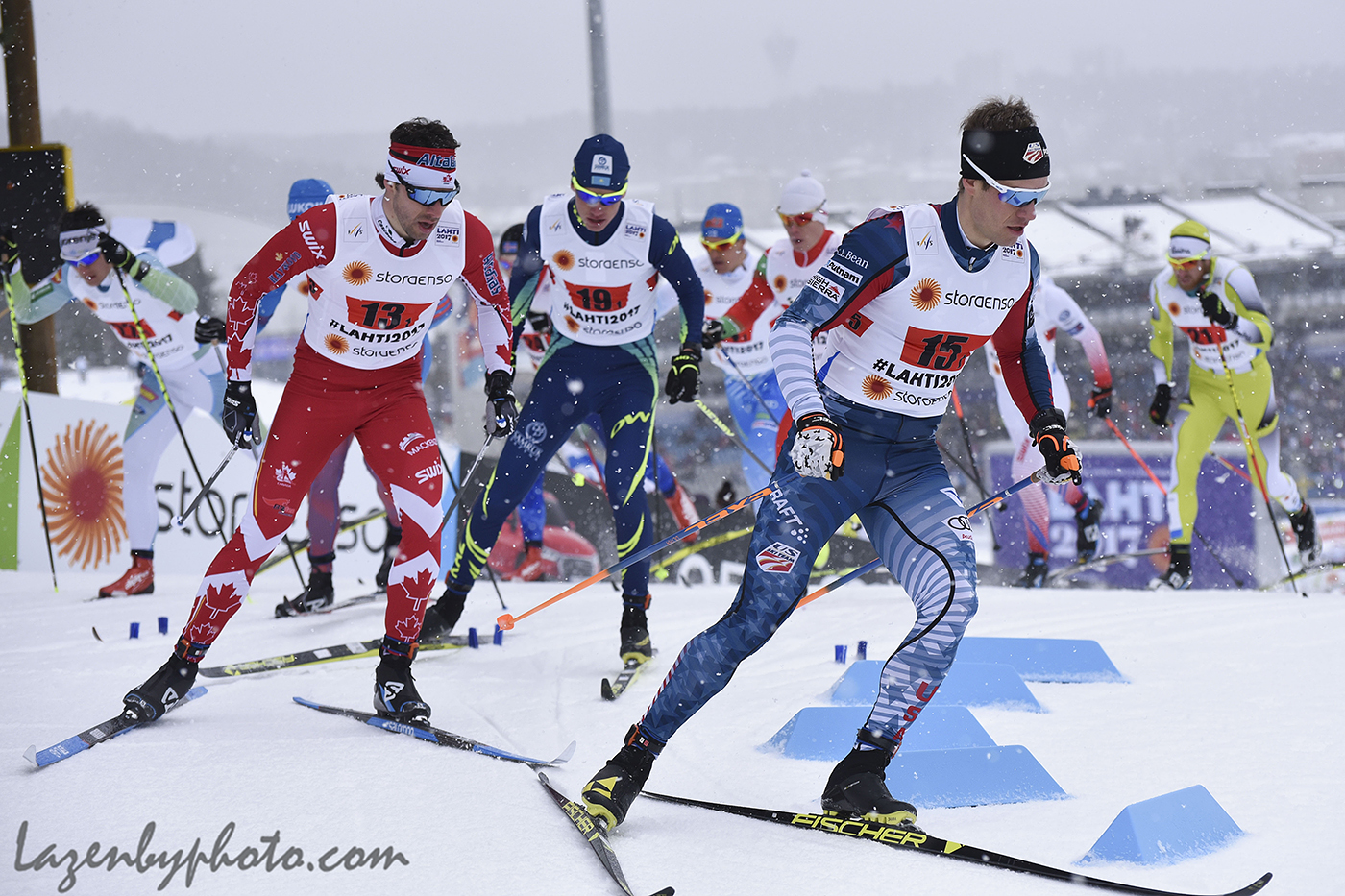
His U.S. Ski Team tenure overlapped with a mix of skiers populating the men’s team. From Kris Freeman to Gus Schumacher, Hamilton has navigated a period often overshadowed by the women’s team. The men’s team, for its part, had a core, of which Hamilton was part of its nucleus. The men’s team was small some years, larger on others. Discretion came into play in nominating teams, sometimes rosters filled out with those meeting objective criteria. The men’s side wasn’t exactly a revolving door, however, it lacked the three to four hallmark skiers who would routinely race into the top-20 in sprint or distance events.
We know Matt Whitcomb had the official title of women’s coach for years. Yet the U.S. rarely named an official men’s coach during Hamilton’s time on the national team. This is not so much a comment on a possible lack of commitment towards the U.S. men as a reflection on the environment in which Hamilton matured as an athlete. Cohesion was often not a trait used to describe the men’s team.
This season marked a turning point. Younger skiers emerged on the team, several of them more than a decade younger than Hamilton. Schumacher set the bar in distance racing, he’s twenty years old. JC Schoonmaker proved to be a reliable sprint qualifier and heat skier. He too is twenty. Ben Ogden, a teammate of Hamilton’s on the SMST2 Team, raced in his first World Championships at 21 years old. Ogden was a U.S. best 11th in the classic sprint qualifier and 17th overall. Hamilton, however, was noticeably absent as a starter in the 2021 World Championship individual sprint. Known more for his skate prowess, Hamilton, according to Whitcomb, had the right to refuse the start. Hamilton did so with the understanding that Ogden just might be able to capitalize.
Ogden did.

Here’s what Hamilton expressed on Instagram after the race.
“People have been messaging me asking why I didn’t race yesterday… valid question and I take it as a compliment that so many have faith in my classic sprinting! I’m not sick or injured. The reality is that after 11 years of trying to crack the code on classic sprinting at this level, I didn’t really think I was going to figure it out in what is most likely the last few weeks of my career, and I wanted to put all my focus into my skate racing, especially with the chance to partner up with one of my role models @gus.schumacher for the team sprint. I knew my decision was a good one yesterday when @ben.0gden was given my start and made the statement that he did, qualifying in 11th from bib 61 and finishing the day in 17th. I’ve said this before but I’ll say it again: this team of American boys coming up is going to do some extraordinary things, and I’m just humbled and grateful to do what I can to contribute to that. But first it’s time to get this old, creaky body in gear and do some skating!”
At those same championships, Hamilton and Schumacher, a hotly anticipated pairing in the skate team sprint, did not advance out of their semifinal. Schumacher, in his first career World Championship start, left early in the tag zone without the tag from Hamilton. Schumacher reversed his progress for a redo, yet by then the time-loss damage was done. Hamilton could have been the prima donna and castigated Schumacher. Certainly, Hamilton’s disappointment was palpable. Schumacher felt he had let an opportunity slip away from Hamilton. The two processed the snafu and moved on.
It doesn’t take a colorful imagination to conjure up a messier scenario unfolding had someone more self-centered been in Hamilton’s place. Elite sport is rife with the self-absorbed. As I have heard Hamilton note on several occasions, he understood the real gravity of the situation — “It’s just a ski race.”
One can also imagine all those younger skiers either on the team or on the cusp took note of Hamilton’s class and humility as he ceded his start to Ogden and comforted Schumacher. Many skiers likely think they are invincible at 20. Their time to retire will come too. Hamilton set a high bar for the men’s team in terms of how and when to acknowledge another skier’s emergence and deal gracefully with race-day disappointment.
“At the beginning of the year, I wasn’t that aware of Simi’s leadership efforts; I knew our team was actively trying to cultivate a group of strong athletes and leaders, but didn’t know the role Simi played in it,” Schumacher wrote to FasterSkier. “Fast forward to the end of the year and I understand Simi’s role in our team culture so much more clearly. He held off his retirement for another year in part to ski fast and support Sophie, but a major goal of his was to facilitate an incredibly tight and positive team, as well as helping us younger guys get acquainted with the whole scene. I learned a lot of this after the team sprint when I was feeling very disappointed in myself. He opened up about how little he cared about the result, and how much he valued our relationship and the experiences of everyone else on the team. He truly wanted to be there for his teammates all year, and when I realized this, so many things he did this season came into perspective. He’s been so quick to help the team and be a friend, sometimes at the expense of his own training and convenience, and I think that has made so much difference for our team culture. This is one of the strongest and most supportive men’s teams in a long time, and I think a lot of that is due to Simi’s efforts as an amazing team leader and friend. I hope we can continue to use what we learned from him in the future, and keep the good momentum going!!”

Schoonmaker had similar sentiments when it came to a “hero” in his midst and Hamilton’s willingness to foster a welcoming environment.
“When I was younger and first started paying attention to the World Cup, Simi was our best men’s American skier so he was the guy I looked up to and aspired to be like,” explained Schoonmaker. “I knew he was an awesome skier and I could tell from listening to his interviews and hearing him talk that he was also an amazing person. It was an incredible experience this season being able to ski with and learn from one of my heroes.
“The men’s team on the World Cup was an incredible and fun group to be around this season and I think Simi deserves a lot of credit for that. He could’ve easily swept Gus and me under the rug but instead, he went out of his way to make us feel comfortable as newcomers on the circuit. He always gave his thoughts on tactics or the course the night before a race and showed that he was invested in each person on the team and had our backs.”
Hamilton also forged a deep friendship with now retired skier Erik Bjorsen. He and Hamilton paired together in the team sprint at the 2014 and 2018 Olympics, where they placed sixth on both occassions.
“Good results don’t always make up an unforgettable day, there are so many other factors that contributed to a dream race day,” Bjornsen said. “I’ll always remember the other shenanigans Simi and I got up to on those days in Sochi and in PeyongChang. We shard everything together; nerves, excitement, and celebration. He’s an amazing friend and the most supportive teammate I’ve ever had. There is no doubt why I had my best performances alongside him.”
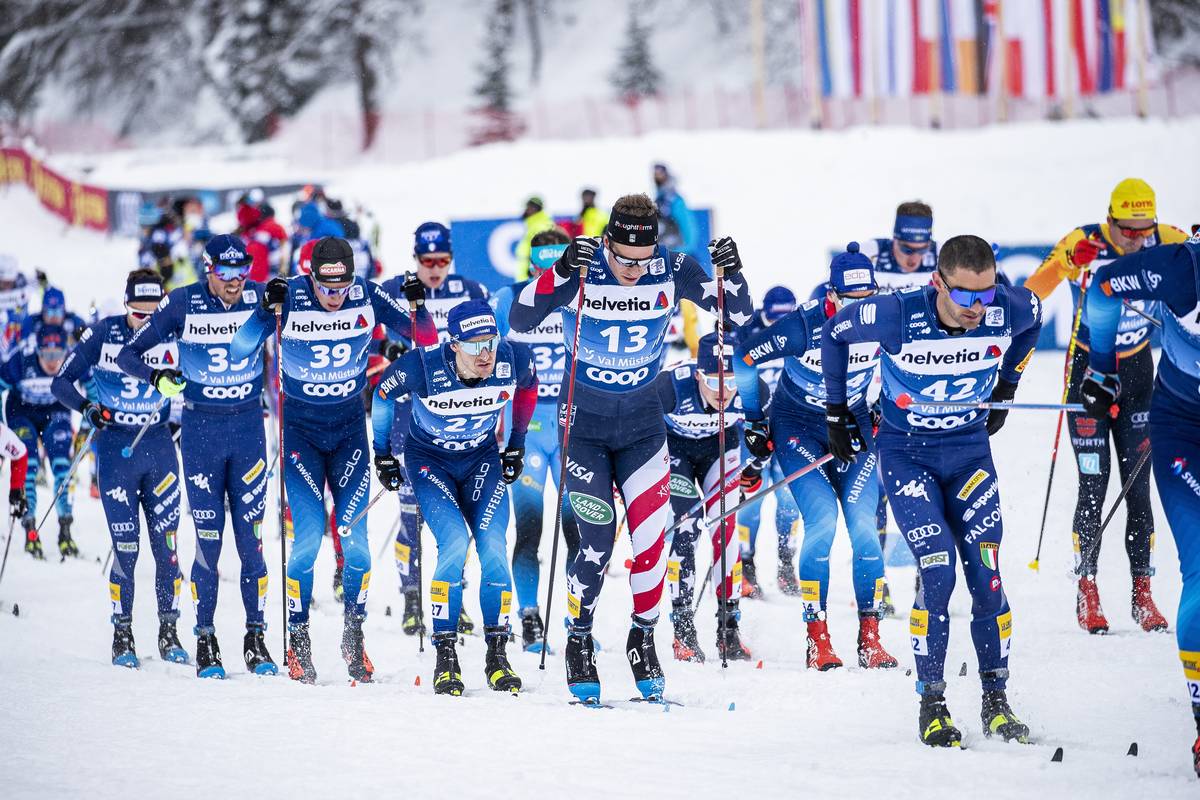
***
Beyond his wife Sophie Caldwell Hamilton, who also retired this season, Whitcomb is perhaps Hamilton’s closest confidant on the team. We sent Whitcomb a series of questions, the same for Caldwell Hamilton if you are keeping tabs. Below we are including his responses.
FasterSkier: Nugget of wisdom from Hamilton that you have learned and now apply in coaching/life:
Matt Whitcomb: Unlocking the strength of the mind is more important than physical talent and hard training. Simi made career-high gains in the last two months of the season with regards to his distance racing (Falun and Oberstdorf), even though they weren’t rewarded with big results. We made this a project, and it worked. Look for distance-racing potential in people who consider themselves sprint specialists. Often, sprinters just assume they will explode in distance races if they redline because they have before. Instead, make the warm-up harder, perfect pacing, and toughen up. Pain is only real if you’re soft.
FS: Most difficult aspect about Hamilton in terms of priming him for peak racing, and how did you navigate that issue?
MW: For Simi, everything is about motivation. The day he won a World Cup in Switzerland, I vividly recall his arrival at the wax room that morning. He was psyched and it was clear he was ready. Just the same, whenever we missed the mark on motivation for a race, he never performed well. But don’t mistake this for motivation as it’s often viewed; I’m talking about ready-to-make-a-kill motivation, rather than watch-TV-or-workout motivation. Getting Simi out the door to train hard or long was never an issue. Most people don’t know that he was a 900-hour athlete.
FS: Easiest part of coaching Simi?
MW: For me, the most important skill a coach can have is the ability to connect with others. Simi and Sophie are great friends, so that connection—that two-way flow of concern—makes coaching them easy. A hard part of coaching is not knowing the unspoken stresses of an athlete. This stuff needs to be tackled first before any training can take.
FS: Non-competition personality trait that made the “team” more of a team.
MW: Simi connects easily with, and inspires developing athletes. They idolize him. He figured out how to be an effective, consistent leader later in his career, and because of it, our men’s team is now a world-class, cohesive environment. I think he’s going to have a lot of fun watching this team succeed, and he’ll know he made a difference.
FS: Simi’s side of the room, by Sophie’s assessment, is fastidious: folded and tucked in everything. How might that trait manifest as an xc skier in Simi’s case?
MW: Well, the side of the room that has the folded clothes and the portable steamer, also has the athlete that needs more structure and tidiness to his plan and goals. The race plan and strategy are more important. The one whose clothes singe on the lamps, and carpet the floors, and whose passport gets lost in the couch cushions, and who might race a semi-final at World Championships on Jessie Diggins’ poles even though they are five centimeters shorter, and who…okay I’ll stop…well, she just needs to be fit and happy on race day. She’s better at adapting in the moment.
FS: Proudest moment as Simi’s coach?
MW: I don’t hang my hat on results, so nothing really jumps out there. That they raced into their 30’s is my proudest accomplishment for them. Many good athletes in the U.S. quit in their early 20’s before they had a chance to bloom. I’m also feeling proud of the way they handled their quarantine during their intended last World Cup races, which should’ve been a week-long celebration of their ski careers. (As I write, they successfully boarded and are on a plane home.)
FS: I know Simi considers you a close friend. How did you balance that when coaching him? How did that enrich the experience?
MW: I don’t subscribe to the you-can’t-be-friends-with-athletes rule when it’s adults coaching adults, but that only works if you can maintain your ability to get tough from time to time. We’ve been through some hard personal times together, and it hasn’t always been just me supporting them. I ski coach because I like to ski and because I like to connect with people. Sophie and Simi are two of the people I credit for me still loving my job after so many years.
FS: Simi’s lasting legacy for each athlete when it comes to team culture?
MW: For Simi, a big goal of his and mine was to stop fucking around with men’s skiing, and finally build a team that works together. This happened this year, and Simi was consistent in his leadership from Ruka, all the way to the team meetings in St. Moritz last week, where he continued to offer thoughts from quarantine. This will last for the team, and for him in his next career.
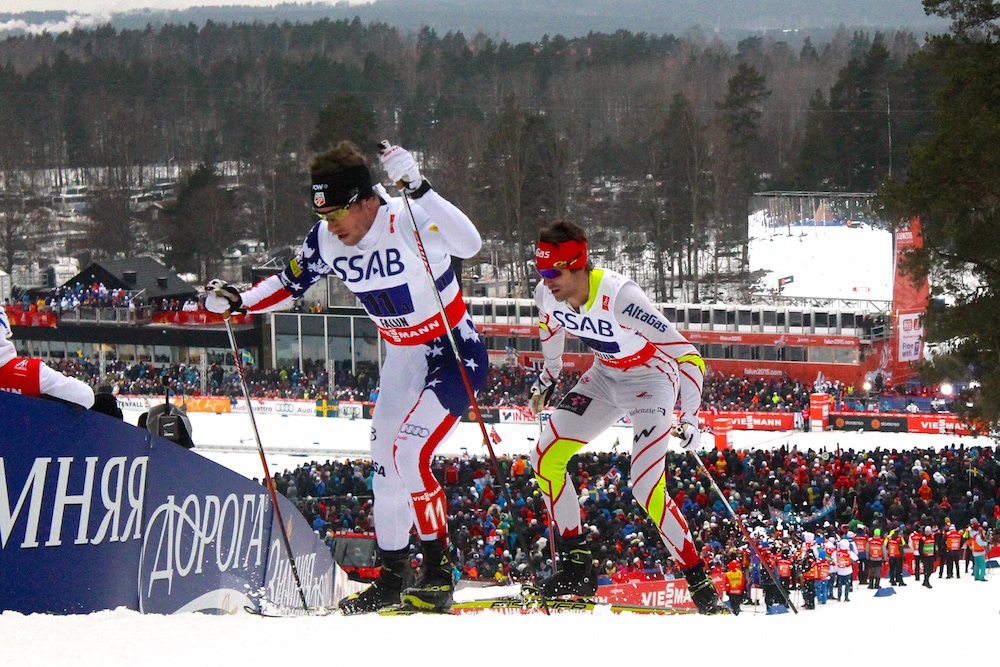

***
What follows is an interview conducted with Hamilton in mid-March. At the time, he was quarantined in Switzerland and awaiting permission to return to the U.S.
FasterSkier: The way it was described to us by Sophie, you are fastidious when living on the road: Tidy and folded t-shirts. Maybe socks nested together. Just pretty much tidiness to contrast her mayhem. Where does that come from?
Simi Hamilton: Honestly, I don’t know where it comes from. My mom, she’s super organized and neat. And I wouldn’t say any of us have OCD, but for sure, I’m more towards that side of the spectrum than many others. You know, I really like to be clean. I don’t feel comfortable if I’m spending time in a room or something and things are just temporarily tidy. Honestly, I think that’s been one of the ways that I’ve been able to cope with, living on the road for so long. I’m in a new hotel room every weekend, living out of a duffle bag. I feel like if I kind of make it my little organized space, it feels a little bit more like home. At least that is what I tell myself.
First of all, on this team, I can say this is a bit of a generalization, but you walk into any one of the women’s rooms and it’s just like a freaking bomb. There’s just stuff everywhere. There are clothes, there’s shit hanging off of everything like you just dumped it everywhere and then you walk into basically anyone of the guys’ rooms and clothes are put away. It’s just funny.
FS: How did you find purpose on the team this year outside the racing? Can you give us a little bit of insight, like, what was your role on the team this year? And if you found purpose, what was that purpose?
SH: I think coming into the season, I didn’t know exactly what my role was. I didn’t know that there was an opportunity to step up. As someone who has been doing this for a long time, and has learned a lot about training and racing and being on the road and being part of a really good organic functioning family team, I didn’t know exactly how it would be. I did sense that there would be an opportunity to step into a leadership role in some way.
I think I did a good job of coming in and, and not trying to force these young men to do certain things or fit a certain kind of mold, or act like a certain type of team. I think a lot of people outside of this team, look at the women’s team and they see what they’ve done. And they try to apply that model or that template to other teams or other situations. It’s the kind of thing where if you want a group of people to function well, you simply have to prop each other up. If you want to build something like that in a positive direction, you have to let it do its own thing.
I don’t think you can ever force the team dynamic to be a certain way. The women’s team has certainly become dominant and successful. But I wanted to allow this entity to morph into its own type of team, and function with its own identity. I simply came into the season just trying to foster that amongst all of us. And I think it worked well.
You know, it was awesome having Gus and JC for the first half of racing and in the second part of the season, we had more of these young men joining us from World Juniors and U23s. It became a really awesome crew and I think you saw them bring out the best in me and Kevin Bolger, Scott Patterson, and David Norris — all these guys who’ve been doing this for a long time. It was rejuvenating and it gave us a spark.
But to be more direct in answering your question, I didn’t do anything beyond trying to be present. I tried to be positive and I tried to lead by example with these young guys.
I always felt like that was something that I never really experienced during my younger years. And that isn’t to say that there weren’t strong leaders on the team. That isn’t to say that they didn’t learn things from people like Kris Freeman, Andy Newell, Torin Koos, and even some of my peers like Noah Hoffman. I learned so much from those guys and I am grateful for that. But I think, for whatever reason, there was never really that cohesive bond amongst every single person on the men’s team. I wanted to encourage us to find that this year, and I think we did.
I honestly think the most important thing that we all did this year to make that happen was we just encouraged everyone to bring what they had to the table without expecting anyone to be someone or act a certain way or be someone they didn’t want to be.
As that became the standard we could simply be ourselves every day and buy into this team. It was cool. It made all the difference. Obviously, I wanted success for myself this year, I wanted some good results. I wanted to feel proud of what I was accomplishing and go out on a good note.
But absolutely, it was more important to feel like we were coming together as a team and doing something organic and positive. It was a huge success.

FS: Just refreshing your FIS profile…you are 33 years old. You’ve been with many different groups as you raced the World Cup. What have you learned about being in close quarters with many different teammates and how to navigate situations where the dynamic is not ideal?
SH: Our ultimate goal with that is creating an environment where, you know, if somebody is doing something, or seeing something, or acting a certain way, that is either detrimental to themselves or detrimental to the team or detrimental to the community that we’re in at that time, that we can soeak up. I’ve learned that it is important to create an atmosphere where someone feels comfortable speaking out and saying something constructive. Sating something like, “Hey, you know, that’s offensive to me, or I don’t think what you are doing is making us ski faster.”
So I think just being able to create that team environment, that team energy, where we all feel comfortable enough with each other that we can change things and have everything be constructive. That’s the work of a high-functioning team. I think that’s valuable and we did that this year.
FS: I know in the past, whether officially or not, it was year to year for you in terms of ski racing. I understand that you as a person do not need the validation of another Olympics to bolster your self-worth. That said, the Olympics are not that far away and that’s a big carrot for a lot of elite athletes. You are forgoing another Olympic experience. What was your calculus in thinking this was the time to step away?
SH: That’s certainly not the first time I’ve heard that. I think honestly, I think both Sophie and I were pretty ready to be done last year. And then I had the season I had last year and I just felt so unfulfilled with what I was capable of doing. And not only individually. It was tough for me just because I was injured and sick for much of the season, even when I was on the road, I felt like I couldn’t be very present, I couldn’t be the leader that I wanted to be on the team. I was just feeling like I wasn’t checking those boxes that I wanted to be checking.
As soon as I said I was going to ski one more year, I felt really good about that. So I knew then basically people would immediately start saying if you’re gonna go through with next year, then why would you just not go one more year to the next Olympics?
I won’t say it’s never been about that kind of thing for me, obviously, there’s something awesome about doing things like going to the Olympics and World Championships, making a certain team, or something like that. But I think, at this point, we’re such dynamic people, we’re well educated, we have some awesome hobbies outside that allow us to experience these amazing communities in Vermont and all these awesome families — We have all these things tugging at us. And I think for both of us, they’re finally really touching hard enough that we want to respond to those things out there.
I also think we’re wanting to start a family soon and start building this house. We want to start writing all the things in the textbook if that makes sense. So it never really felt like we were giving up on the team, or the Olympic movement. I don’t think need those things in our lives anymore to progress.

FS: In talking about you, Bill McKibben mentioned an anecdote about you skiing off some peak near Aspen for your ninth birthday. And some of the stories are legends. I know you like moving fast, be it on skis in the mountains, climbing, biking, whatever. You probably could have been a lot of things when considering the pro-athlete realm. Can you provide some insight into your path as an athlete?
SH: Certainly growing up in a place like where I grew up, I always had a huge draw to getting outside and doing things other than just cross-country skiing. I plan on doing a lot more of that now. But I have come to realize in the last few years of my career that it’s so much more important to find something that is simply fun. I also need to feel like I’m doing something worthwhile. What I started appreciating about cross-country skiing was just the amount of hard work to be good at it. I think especially as a US cross country skier doing that, dedicating your entire life, to doing something like that for 10 years, and not getting a ton of recognition for it — and I say that with a grain of salt because obviously we have this amazing community of supporters and we do get a lot of recognition for what we do, but when you compare the amount of praise and financial earnings between like what we’re doing and between what freeskiers are doing or maybe some things that I could have potentially seen myself doing if I hadn’t have gone down this path, they are incomparable.
But doing this for the last 10 years has taught me how incredibly valuable humility is. And just like I said, sheer hard work, and commitment, and dedication. And I think that those things that I’ve learned are going to be the most valuable things that I can use going forward in life. And those things are the things that I want to pass down to my children and have them pass down to their children.
FS: The concept of humility is interesting when thinking of elite athletics. You have a reputation as an amazing all-around athlete let alone a cross-country skier. But if you can think back over the decade, and racing on the World Cup, that is a tough scene. Some weekends it works out, others someone might get their ass-kicked. Can you reflect on your humility and how that evolved?
SH: I don’t think there’s anybody who comes on to the World Cup scene, from any country, who isn’t somewhat confident. But, I think a lot of people say that they’re ready for this level of racing, and then when they’re experiencing it, it’s like they don’t have any idea of what hit them or what is coming.
It certainly took me a long time to figure out how to be good. And it still boggles my mind to see how consistently good someone like Klæbo or Pellegrino. Basically, weekend after weekend after weekend after weekend they are one of the top five or on the podium. That is such a ridiculously high-level sport.
It certainly took me some time to figure that out. As I progressed I started to appreciate the lesson in patience more and more. Knowing that maybe I would go two periods on the World Cup without really having a truly awesome race. But you know, maybe in that third period or something I would have a top-10 or podium or a final. That is worth waiting for and working hard for. It took me a long time to learn that lesson. Especially coming from a pretty successful career as a junior skier in the US. I certainly was expecting it to be hard as it was and take as long as it did, but again, as I said with your previous question, that’s just the part of this sport that is pretty cool: You just have to keep your head down for a long time. And be doing it for the right reasons. Because if you’re not, then you’re not going to be able to grind away.
FS: The usual question, what are you most proud of in terms of race results?
SH: Obviously, my win in Lenzerheide, my third place in Canada, were all very special. They were awesome days. But I think, you know, I would say my three best moments in my career on the World Cup at least, and I’m not ranking these because they’re all a little bit different. But three experiences stand out to me as incredibly special.
The first was watching Sophie win her first World Cup in Oberstdorf. It sucked because I was sick. I had gotten sick the night before, during the Tour. I wasn’t even at the venue. But the coaches gave me the OK to go and pick her up in one of the vans. I had some great alone time with her. I was just so happy for her knowing how hard she worked and knowing how much that meant to her, to get to that point was pretty special.
The other two were the 2017 Lahti World Championship classic team sprint and the 2014 Sochi Olympic team sprint and those were both with Eric Bjornsen. They were races where we both skied well. But more important than that, everything just kind of clicked. And I felt on both of those days that Erik and I were racing for each other. And that felt cool to do. I have felt that in some distance relay teams and some other races throughout my career, but, I think those two days stand out to me as just being so connected with somebody else, that we will race until your heart explodes for that other person. It’s a cool feeling to have. And I’ll for sure reflect on those days.
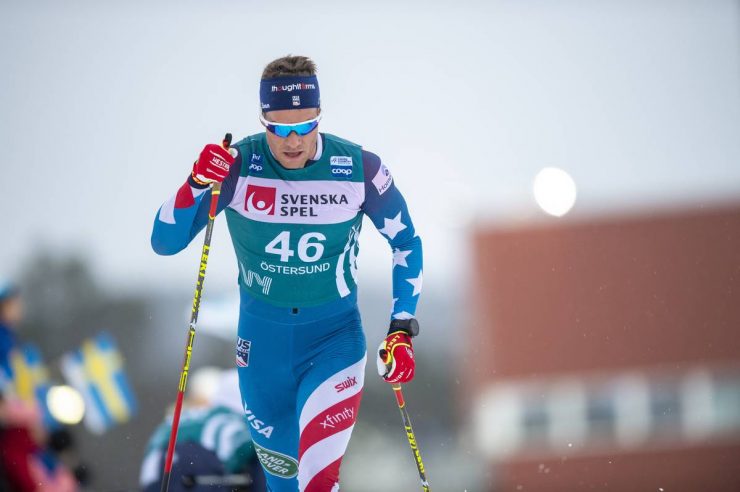
FS: Is that perhaps because you had a personal connection specifically with Erik?
SH: I definitely wouldn’t say that I wouldn’t have had that same experience with anybody else. But, Erik and I always had a close, really special relationship with each other. And I think we both understood each other. We understood what motivated the other person. We understood what bummed the other person out.
I think we were doing it for the right reasons. Just being able to share an experience like that with someone who really gets you and who you get is pretty cool. I’m sure it’s like when you’re on a team, playing a team sport, whether it’s hockey or soccer or baseball, whatever it is, just being able to share a huge success like that with your whole team, it’s got to be a very similar feeling.
I have enormous pride for what Jessie did this season or our girls are on a podium, we always feel a lot of that. But, I think to be in the team sprint with one other person who is one of your best friends in life, there’s not a lot of substitution for that.
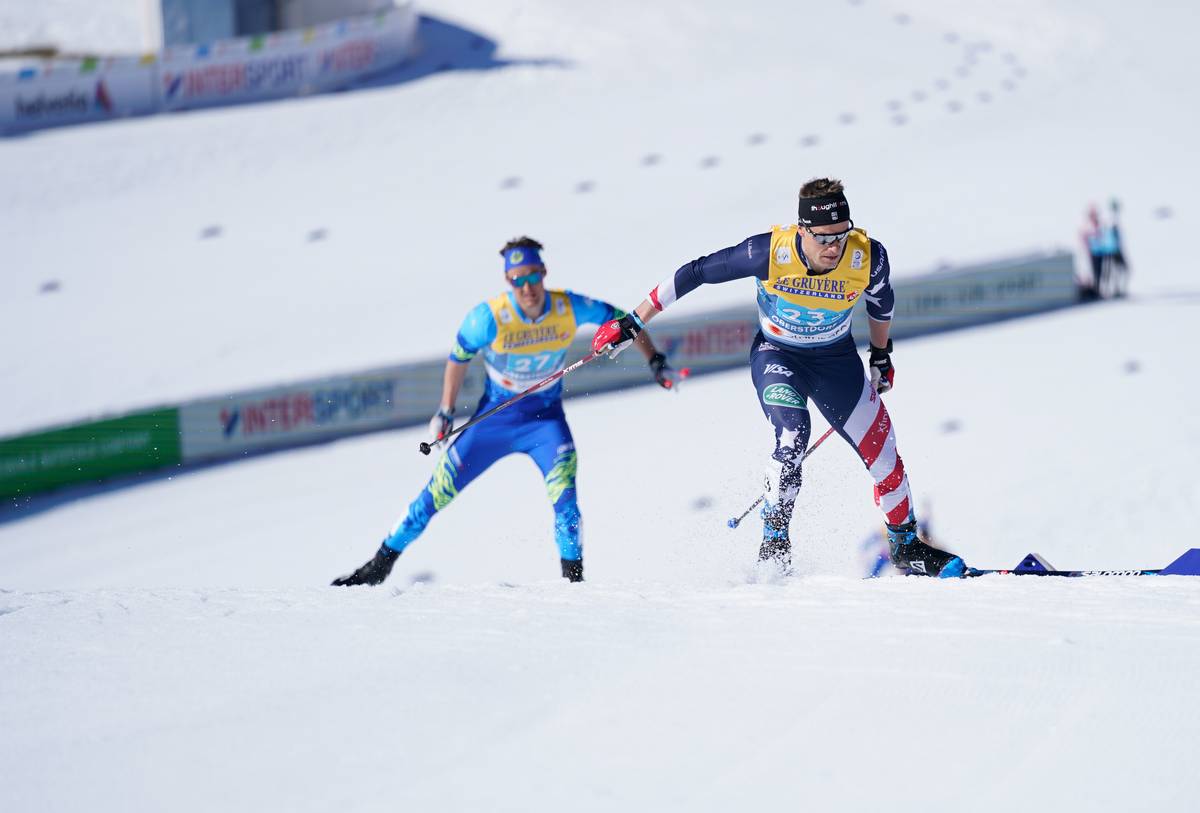
FS: That brings up the experience this year at the World Championships with Gus. Maybe give us some insight. You are paired with an exceptional skier in Gus who is more than ten years your junior. This was his first senior World Championship race and I am sure he was nervous. What was that emotional trajectory like for you?
SH: I definitely won’t say that that day was not heartbreaking. But, I will also say, with 100%, truthfulness and accuracy is that it wasn’t heartbreaking because of Gus. It was just heartbreaking because of the situation. It wasn’t that we got unlucky, but we didn’t get lucky that’s for sure.
Gus would have done anything for me that day. He knew how important that day was for me, but I think he thought the result was way more important for me than it was. And the result was absolutely important. We both went into that day wanting to get on the podium, and we knew that we could but it had to take the perfect race from both of us – and probably perfect conditions for both of us, which, you know, it wasn’t.
It was never is never about the result for that day, that was our goal and it would have been a perk, but there was so much more about that day that was important. A lot of what happened was, I think, it can mostly be attributed to Gus just not having that much World Cup experience yet and team sprint experience, and being able to adapt as you’re racing especially on a day when conditions are changing that much.
And, you know things were so different from even a couple of minutes before. What happened that day was we were in the second semi-final which was an unlucky thing in the first place, just because those springtime championship races in the middle of the day the conditions are changing so quickly. The course is slowing down like 10 seconds per lap — that’s how much it was breaking down as it was getting softer and slower. So the first couple of tags we did, the snow was decently fast, but you could tell it was starting to slow down. But towards the end of that semi where you’d come into the tag zone, it was just everything you could do to try to sprint through slush.
I think on that last tag, when I was tagging Gus, he just thought the tag zone was way faster than it was, and he started going with the guys who were around him. And that was just a little bit too early, and we missed the tag. I made the split-second decision to not try to hide that and actually go back into the zone with him and get the tag off because I just figured, you never really know what’s going to happen in that lead pack, there could be a crash, you something could happen. I figured it was worth doing it right because I also knew the jury always sees if you tag or not and I knew we had not tagged.
So I made that call to tag. We skied our asses off but it wasn’t enough.
He was devastated. I think that he finally understood that that is just part of racing — shit happens and it sucks when it happens on a day like that in a race like that. That’s one of the lessons he’s gonna have to learn, and I mean he has learned, I guess that’s kind of a rude awakening for your first World Champs. But this season, as I said, it’s been so much more about getting those results and what I could do in my last World Championships.
All of those things would have been awesome and they were goals that I had, but it was about way more than that, and I think at the end of the day we both recognize that and appreciate that.
I’m just psyched to see what he can do in the future and I’m sure he’ll start doing team sprints with one of those other young guys. I’m sure that in six years or 10 years, however long, they will be winning medals and it’ll be pretty cool to see.
FS: To close out, let’s talk about risk-taking. As someone who loves adventuring in the mountains, and I mean real-deal adventures, you’ve got to be constantly assessing risk. You are married. Thinking about kids. Renovating a house back in Colorado. Those things make people reassess. Skiing off North Maroon last spring, for example, that brings a certain spice level and some real risks to mitigate. All things considered, how do you consider risk-taking now knowing you will be lured into those amazing Aspen hills soon?
SH: I will be the first to tell you that compared to 10 years ago, I have no desire to really push the limits too much. Obviously like by doing anything even getting in a car or whatever there’s risk involved. And there’s a lot of things that we do, we do them because there is some amount of risk. It’s cliché to say, but that’s what makes you feel alive, like if you’re not doing anything that isn’t sometimes a little bit dangerous, then you’re not appreciating life, I think, to its fullest extent. But, at the same time, I don’t need to be out there like filming all these gnarly things and jumping off shit on my skis or my bike. I don’t think I need to be doing that to feel a sense of self-worth and value to society. I feel that in the last few years, I’ve started to recognize some individuals out there who are doing an unbelievable job with kind of telling the story versus posting the sickest photo or skiing the gnarliest line. And to me, that’s so much cooler, and a more admirable way of going about your life, people figuring out a way to tell this really interesting story and cool interesting experiences and connecting with people that aren’t exactly like you.
So that’s what I’m most looking forward to.
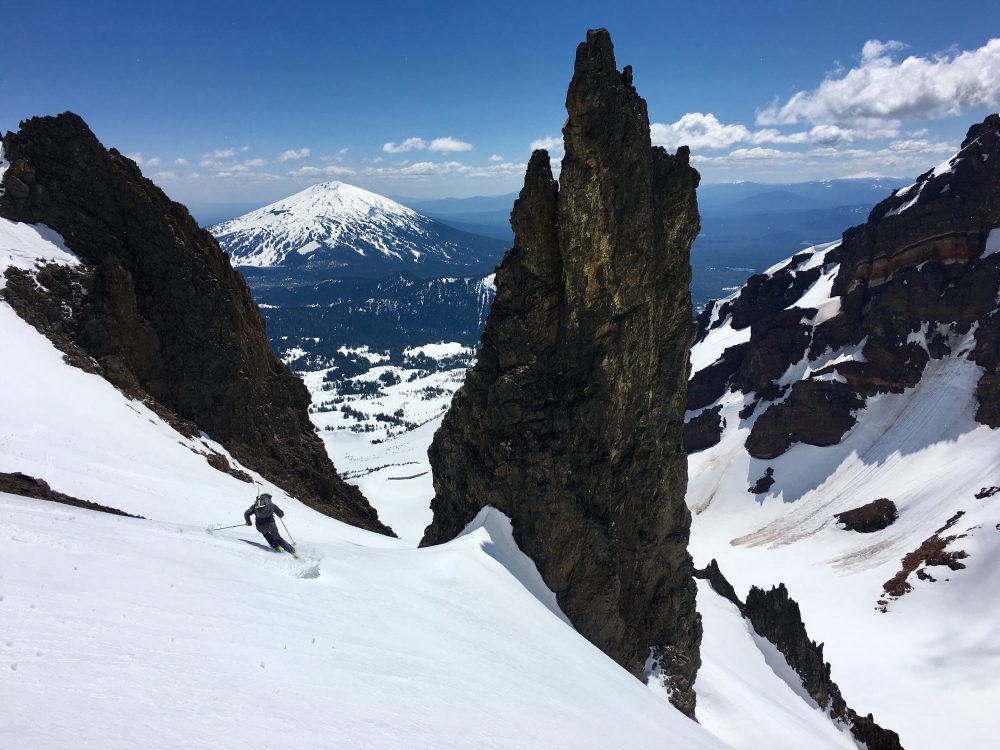
Jason Albert
Jason lives in Bend, Ore., and can often be seen chasing his two boys around town. He’s a self-proclaimed audio geek. That all started back in the early 1990s when he convinced a naive public radio editor he should report a story from Alaska’s, Ruth Gorge. Now, Jason’s common companion is his field-recording gear.



